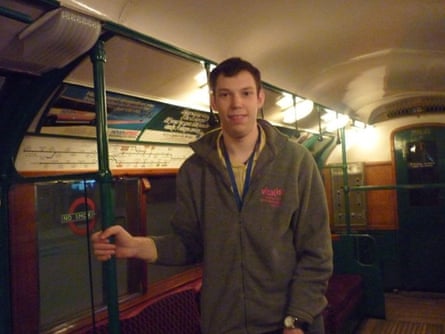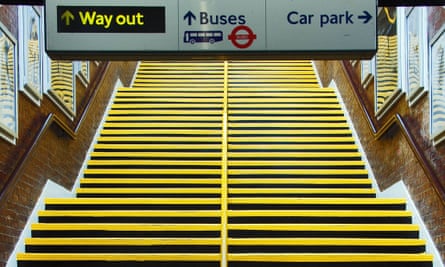Arriving at Liverpool Street station on a quiet afternoon, Ben Holt, who has cerebral palsy, found that only one platform offered a step-free route out, and he was on the wrong side of the tracks. “With no one around to help me out, I had to help myself,” he said. Risking a hefty fine, he stopped the escalator in order to walk up it, sweet-talking the station staff who were waiting at the top.
Ben will soon be boarding the Tube once again to tackle escalators, stairs and more, in an attempt to complete the Tube Challenge by visiting all London Underground stations in a single run.
Travelling through 270 stations and 26 London boroughs would be a mammoth task for anyone - but now imagine that only 24% of those stations are accessible to you. That is precisely what Ben will be thinking when he’s speeding through the 250-mile network, stopping at each station to take a photograph, in an attempt to break the current 16 hour, 20 minute record. Regardless of whether or not he beats that time, if Ben makes it all the way to his final stop at Epping station, he will have set a record as the first disabled person to complete the challenge.

London’s 151-year old transport network provides mobility, independence and freedom to 1.2 billion passengers a year, but still often fails many disabled and elderly travellers through outdated and inaccessible designs, such as stairs, narrow doorways and wide gaps between the train and the platform. This lack of mobility within Transport for London’s (TfL) system is not simply a matter of inconvenience; mobility is access to education, employment, leisure and an independent lifestyle.
With changes to disability benefits alongside austerity cuts to TfL, campaigners feel that the city is losing sight of its commitment to inclusive transport, which it boldly vowed to deliver alongside the 2012 Olympic and Paralympic Games. Earlier this month, Paralympian Hannah Cockroft challenged London mayor Boris Johnson to spend one working day travelling by wheelchair on the Underground network - he refused.
While travel apps like CityMapper currently lack the technology to cater for varying accessibility needs, TfL’s accessibility guides provide a solution to the subterranean maze. Until 1993, fire regulations prohibited the use of wheelchairs on the underground, and although retrofitting has begun, slow progress leaves many stations stuck in limbo. Not every hurdle can be anticipated, and frustrations are faced every day by disabled travellers across the city - one case is highlighted in this ‘race the tube’ challenge.
In 2010, a major step-free upgrade of six Tube stations was scrapped due to “pressures on TfL’s finances”, and the £20m already invested in the project was wasted. This came as a serious blow in light of a commitment made in 2006, when TfL promised to make one third of Tube stations step-free by 2013.

A year on from the promised delivery date and only 66 stations are ‘step-free’ - with around half of those providing fully level access from the street to the train, and many still have to mind the 30cm gap into the carriage. Since the 2006 pledge was abandoned, TfL now promises to make “at least 28 more” Tube stations step-free by 2024. If this target is met, disabled and elderly travellers will still have to wait another 10 years before they have access to one in three stations on the Underground network.
Transport for All (TfA) director Faryal Velmi acknowledges that the journey to an accessible Underground system is a long one - especially when it involves upgrading a piece of Victorian infrastructure - but when building new stations, accessibility should take centre stage. In 2019, the long-awaited Crossrail project is due to open, but up until a few weeks ago, seven of the 38 stations on the route were set to remain inaccessible.
“You can’t build something costing £15bn without making it fully accessible to all”, says Velmi, who organised a day of action last year that brought 150 campaigners together outside Crossrail’s Canary Wharf offices.
TfA estimated that it would cost 0.2% of the £15bn budget to make those seven stations step free, and Crossrail declared a completely accessible network earlier this month. Just one day after TfA’s victory, the mayor announced a £75m step-free improvement fund, promising to install lifts at “around a dozen” stations over the next decade.
As the network improves and becomes more accessible to passengers, vast areas of the city once unreachable by the Tube open up, increasing mobility and giving disabled and elderly travellers the freedom that is taken for granted by many commuters every day. Intermediary improvements, like manual boarding ramps, bridge the gap between transport immobility and independence while travellers hold out for a fully accessible system.
In the meantime, Ben is gearing up to face all 270 stations in order to highlight the Underground’s inefficiencies and to set the disabled world record. He hopes that in taking on the challenge he will change people’s perceptions of disabled travellers, and will inspire confidence and independence in those who feel let down by TfL.
“This is my day and I’m not going to give up,” said Ben. “We are capable of doing anything we want, even if it’s going to take more effort. I’m tired of feeling like a nuisance when I ask for help on the Tube.”

Comments (…)
Sign in or create your Guardian account to join the discussion